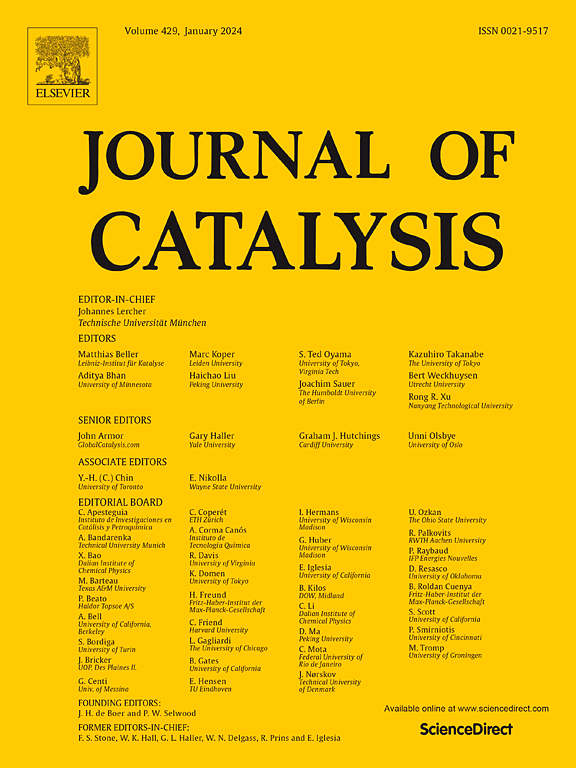n位异构化提高联吡啶基共价有机骨架的CO2光还原性能
IF 6.5
1区 化学
Q2 CHEMISTRY, PHYSICAL
引用次数: 0
摘要
包含具有多个氮原子的杂环的共价有机框架(COFs),如三嗪、联吡啶和七嗪,被认为是CO2光还原的有前途的非均相光催化剂,而n原子相对位置在这种转化中的实质性影响很少被系统地研究。在模拟阳光照射(1000 W/m2)下,设计了一组含联苯、2-2′-联吡啶和3-3′-联吡啶的等结构卟啉基COF催化剂,用于CO2光还原。结果表明,与常用的联苯和2 - 2′-联吡啶单元相比,含有3-3′-联吡啶的卟啉COF的光电性能得到了显著提高,3-3′-Bpy-COF的CO产率分别是2 - 2′-Bpy-COF和Bp-COF的2倍和10倍。进一步研究了提高光催化活性的原因和反应机理,揭示了上述N位的微小变化导致3-3 ' -Bpy-COF的偶极矩增大,促进了光生激子的分离和转移。此外,x射线光电子能谱(XPS)和密度泛函理论(DFT)计算表明,3-3′-联吡啶n原子可以有策略地调节卟啉M−N4活性中心周围的电子密度,从而稳定*COOH中间体,降低速率决定步骤的能垒。这项工作强调了卟啉和N原子在COFs光催化剂中对CO2还原反应的立体位置的协同影响,为设计具有特殊光催化能力的COFs提供了新的见解。本文章由计算机程序翻译,如有差异,请以英文原文为准。


N-position isomerization to enhance the CO2 photoreduction performance of bipyridine-based covalent organic frameworks
Covalent organic frameworks (COFs) that incorporate heterocycles featuring multiple nitrogen atoms, such as triazine, bipyridine, and heptazine, are seen as promising heterogeneous photocatalysts for CO2 photoreduction, while the substantial effect of N-atom relative locations in this transformation has rarely been systematically studied. Herein, a collection of isostructural porphyrin-based COF catalysts bearing bipheyl, 2–2′-bipyridine and 3–3′-bipyridine are judiciously designed for CO2 photoreduction under simulated sunlight irradiation (1000 W/m2). As results, comparing with the frequently used biphenyl and 2–2′-bipyridine unit, the porphyrin COF incorporating 3–3′-bipyridine yields a significant enhancement in photoelectric properties, and the CO production rate of 3–3′-Bpy-COF is 2 and 10 times higher than that of 2–2′-Bpy-COF and Bp-COF. Insights on the origin of the improved photocatalytic activity and reaction mechanism are further investigated, revealing above tiny variation of N sites results in a larger dipole moment for the 3–3′-Bpy-COF, facilitating the separation and transfer of photogenerated excitons. Moreover, The X-ray Photoelectron Spectroscopy (XPS) and Density Functional Theory (DFT) calculations reveal that the 3–3′-bipyridine N-atoms can strategically adjust the electron density surrounding the M−N4 active center of porphyrins, which stabilize the *COOH intermediate and reduce the energy barrier of the rate-determining step. This work highlights the collaborative influence of porphyrin and the steric location of N atoms within COFs photocatalysts for CO2 reduction reaction, offering a new insight to design COFs endowed with exceptional capabilities for photocatalysis.
求助全文
通过发布文献求助,成功后即可免费获取论文全文。
去求助
来源期刊

Journal of Catalysis
工程技术-工程:化工
CiteScore
12.30
自引率
5.50%
发文量
447
审稿时长
31 days
期刊介绍:
The Journal of Catalysis publishes scholarly articles on both heterogeneous and homogeneous catalysis, covering a wide range of chemical transformations. These include various types of catalysis, such as those mediated by photons, plasmons, and electrons. The focus of the studies is to understand the relationship between catalytic function and the underlying chemical properties of surfaces and metal complexes.
The articles in the journal offer innovative concepts and explore the synthesis and kinetics of inorganic solids and homogeneous complexes. Furthermore, they discuss spectroscopic techniques for characterizing catalysts, investigate the interaction of probes and reacting species with catalysts, and employ theoretical methods.
The research presented in the journal should have direct relevance to the field of catalytic processes, addressing either fundamental aspects or applications of catalysis.
 求助内容:
求助内容: 应助结果提醒方式:
应助结果提醒方式:


